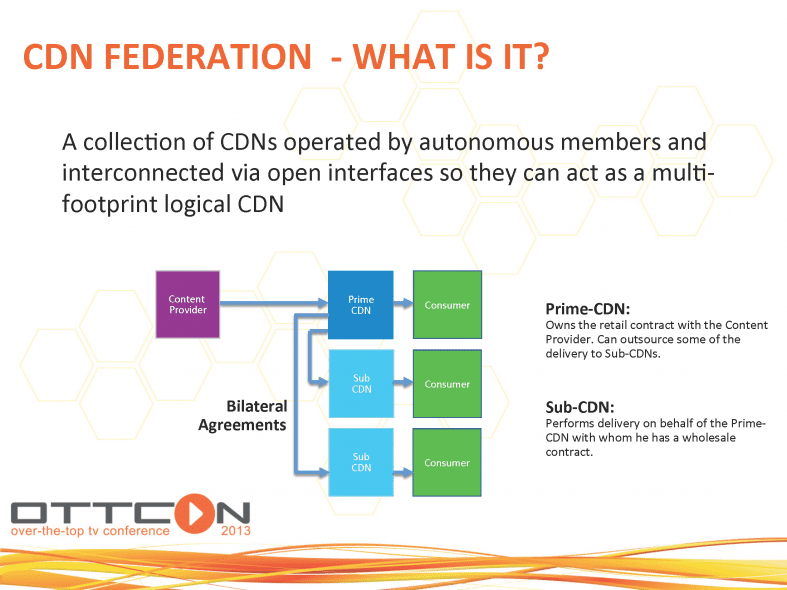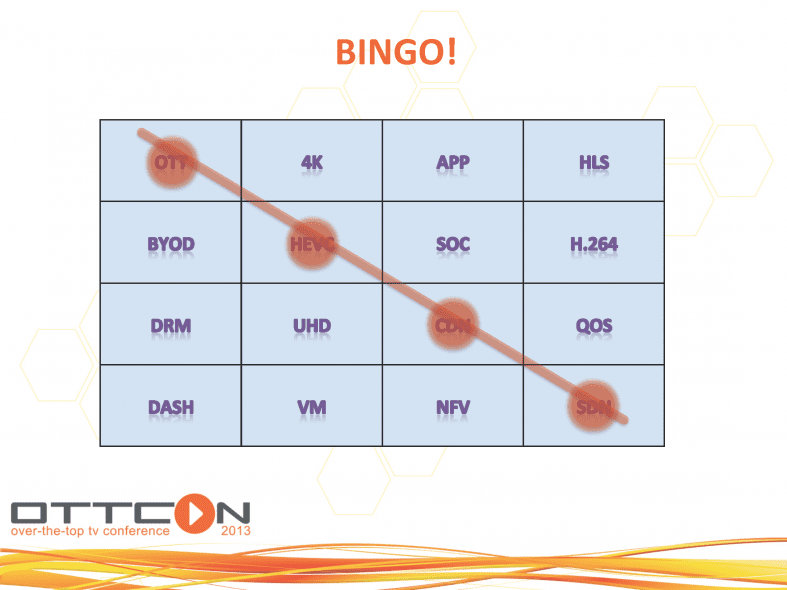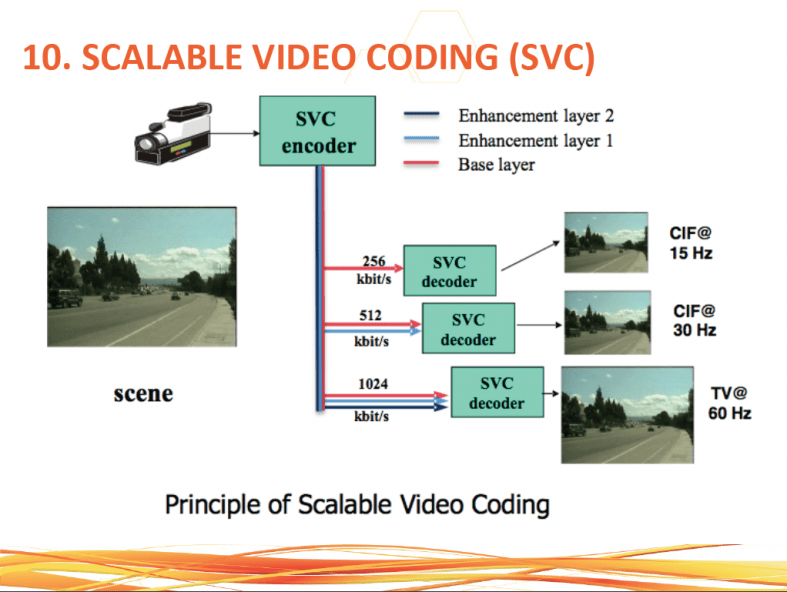Technologies that will offer higher quality viewing experience & enable new OTT services
Introduction:
The use of over-the-top (OTT) solutions to deliver streaming video to the TV and second screen devices is now a reality. Almost all Internet-connected devices (WiFi, Ethernet, 3G/4G) are capable of receiving multiple sources of OTT video- both free and subscription fee based. Though streaming video services are at the center of OTT, there other uderlying technologies that must be present for this market to continues to evolve and grow. As new, pioneering companies move from testing the water to diving in full force—the OTT industry will change, and dramatically so.
This article summarizes several new technologies described by Cisco, Akamai, and Discretix during the 2013 OTTCON held last week (March 19-20) in Santa Clara, CA.
OTT Sessions on Enabling Technologies:
1. OTT Technology Enablers: HEVC, CDN, and SDN, by James Field, Director of Technology, New Initiatives – NDS (now a part of Cisco). Three of the key technology enablers that will drive OTT innovation and growth were discussed by Mr. Field:
-HEVC is a next generation content encoding standard that provides increased compression rates to improve video throughput and quality. The result is a much better mobile video experience along with introduction of advanced video services, such as 3D, and ultra high definition video (up to 8192×4320 pixels). HEVC is the successor to H.264/MPEG‐4 (Advanced Video Coding). It provides a 50% bandwidth savings at equivalent video quality- or higher quality resolution or frame rate. With this technology an operator can reach more OTT customers and also more end point devices through the same speed broadband access. Standardized only this January 2013, HEVC silicon was forecast to be shipped by the end of this year (mostly for encoding). Decoding could be implemented in software in the end point device, assuming it contained a fast enough microprocessor. But embedding HEVC chips in mobile devices will be a cost sensitive market. Hence, the first chipsets will likely target high-end “4K” Ultra HD TV sets.
-A Content Delivery Network (CDN) is a large distributed system of servers deployed in multiple data centers within the public Internet. CDN Federation is a collection of CDNs operated by autonomous entities/service providers and interconnected via open interfaces, so as to appear as a single logical CDN. Such a multi-footprint logical CDN may enable improved video quality while providing additional reach and OTT service revenue potential and reach.

CDNs are implemented with caching only OR with a combination of caching and network QoS that are tightly integrated (for HD content, Connected TVs, Mobile content, Live video streaming, etc). CDN market vendors include Transit Providers (like Level 3 Communications) as well as Pure Play CDN vendors (like Limelight, Akamai, CDNetworks, etc). Network Service Providers want to participate in the CDN value chain to generate new revenues, improve user experience and reduce network costs.
-Software Defined Networking (SDN) is an emerging network architecture where the control and data planes are decoupled (and reside in different equipment) to enable flexible configuration, network management and programmability. An Open Network Environment (ONE) approach to SDNs creates more resilient network intelligence and can enable more agile service delivery. Open Flow protocol is being standardized by the Open Network Foundation (ONF).
Note: This author has written numerous articles about SDN. We believe it is too early to be used in delivering OTT content to mobile or fixed line subscribers. Here are a few recent SDN blog posts:

2. OTT for Mobile Devices – An implementer’s Checklist, by Raviv Levi – Director of Product Marketing, Content Protection Products – Discretix
Mobile devices are a crucial element of all “TV Everywhere” deployments. Video quality and effective delivery to mobile devices require different video formats and resolutions. Wireless networks introduce both connectivity and throughput variance, requiring support for adaptive bit rate streaming protocols. Scalable deployment across multiple platforms – The number of Android and iOS device variants is growing exponentially. Service providers cannot effectively test and debug their “TV Everywhere” application on all existing smartphones, tablets, screen sizes, OS versions and processor platforms. Cost effective deployment requires a single application that can be deployed across the entire mobile device eco-system. Security – Open devices, un-managed networks and multiple untrusted 3rd party applications, add significant complexity to the security of the “Mobile TV Everywhere” applications. Access to premium content from the major studios depends on the proper hardening of content protection technologies. In his presentation, Mr. Levi described the key technology considerations for TV Everywhere deployments on mobile devices and shared lessons learned from devices already in service across the world.
3. OTT and Scale: The Darkness and the Light, by Will Law, Principal Architect – Media Engineering – Akamai
The current architecture and distribution methods of delivering over-the-top content struggle to deliver a single live event to millions of concurrent users. How can they possibly hope to cope with even a fraction of cable’s capacity? This session examined ten new technologies that can combine to help address the problem of delivering live OTT content at massive scale.
The ten technologies described by Mr Law were:
-HEVC – will cut transport costs for OTT content only IF quality parity is maintained
-Increasing device compute capability -enabling software decoding of complex compression schemes
-Storage density growing exponentially- faster than compute capability (more local caching of multi-media content)
-Multi-cast OTT video delivery – for live sports events, election coverage, concerts, royal weddings, OTT linear TC for marquee programming, top 100 Netflix videos, etc)
-Peer assisted video delivery -get video from your peers instead of a conventional video server. Needs overlay security and control plane
-Tiered pricing plans -already in use by most 3G/4Gmobile carriers, may spread to wireline Internet access; it’s a telco business practice rather than a new technology.
-Local caching networks -caching used to only exist within CDNs. Now major telcos and other carriers (e.g. MSOs) are building out transparent cache layers within their own networks. Federation of content between cache networks is next.)
-Better optimization of mobile data traffic by wireless telcos (small cells, more LTE deployments, self organizing networks, etc)
-Fiber transit capability dramatically increasing in the core network (40G/100GE over fiber being deployed now).
In Sept 2012 NTT demonstrated transmission of 1 petabit (1000 terabits)/sec over 52.4 km of optical fiber. That’s equivalent to sending 5,000 HDTV videos of two hours in a single second. However, fiber is not being deployed that rapidly to cell towers, and (with the exception of Verizon FiOS and some independent telcos) not directly to the home.
-Scalable Video Coding with new encoders/decoders capable of operating at mutliple bit rates/frame rates/frequencies.</div


Other new technologies besides the above were identified as:
– 4K video- a new resolution standard designed for digital cinema and computer graphics which has a horizontal resolution on the order of 4,000 pixels.
— Increased device screen resoution (e.g. Samsung Galaxy S4 smart phone is 1080p)
– Server bits/power (Watts) is increasing which is critically important to lower power consumption & cooling in data centers.
— Residential fiber AKA FTTH (not happening in a big way in the U.S.)
— WiFi Carrier Offload (popular with some wireless carriers, but not others)
– HTTP 2.0 is the next planned version of the HTTP network protocol used on the WWW. It is an alternative to SPDY- an HTTP compatible protocol launched by Google and used in Chrome, Firefox and other browsers.
Editors Note: Time constraints and great difficulty with this website’s word processor/editor prevented a more complete summary report of these three excellent OTTCON sessions. Please contact the author if you are interested in learning more as part of a consulting project: [email protected]
One thought on “Technologies that will offer higher quality viewing experience & enable new OTT services”
Comments are closed.



Ventuno is a SaaS based OTT platform that allows content owners to launch, manage and monetize their video streaming service (On Demand/Live) for Web/Mobile/TV